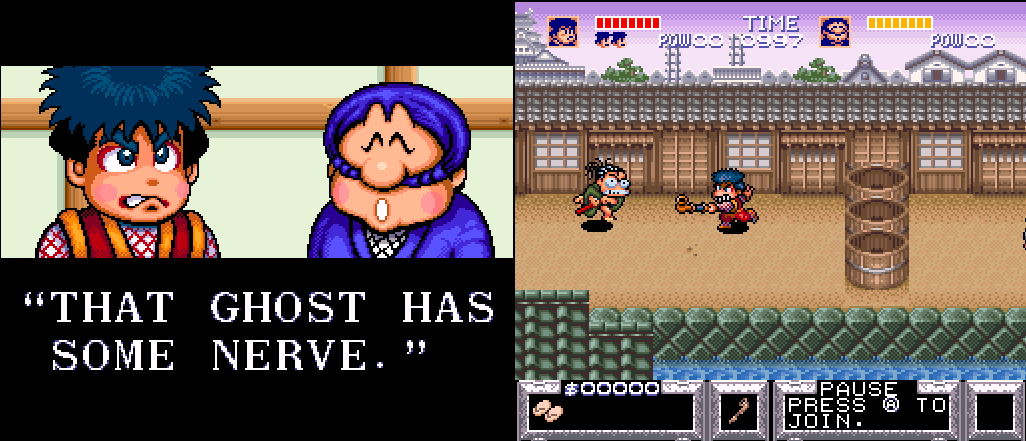Ganbare Goemon, or The Legend of The Mystical Ninja as it was called in North America, was one of my favorite series growing up. These games always had a good mix of action, adventure, and humor. Starring a colorful cast of characters and set in a cartoon-like feudal Japan, it’s one of the few series of its time that fully embraced Japanese folklore.
It’s main character, Goemon, was based off of Ishikawa Goemon, the famous thief depicted in Japanese folklore. The first few games presented him as this thief but subsequent games made him into your average run-of-the-mill game hero. This history is not very well known overseas, seeing as how so little entries in the series were released outside of Japan.
There have been dozens of games spanning multiple systems starting with arcades, then moving on to the NES, SNES, Nintendo 64, Game Boy, DS, both PlayStation 1 and 2, and even mobile. There was also an anime series. Only four of the twenty-nine titles made it stateside due to Konami stating that these games were too specific to the Japanese market. Nevertheless, I enjoyed the games that did make it over here.
What set Goemon apart from other video game heroes was his weapon of choice. He didn’t wield traditional game weapons like swords or guns. Instead, Goemon brandished a Japanese smoke pipe to pummel baddies with. As a kid, I never really gave much thought as to how ridiculous something like that was. I just enjoyed the ride.
While there have been several arcade and NES titles dating back to the mid-eighties, the first game to make it stateside was Ganbare Goemon: Yukihime Kyuushutsu Emaki for the SNES. This was of course renamed to something more appropriate for American audiences, The Legend of the Mystical Ninja.
Along with this localization came terrible translations for its main characters Goemon and his hammer toting pal, Ebisumaru. They were given the names Kid Ying and Dr. Yang, the most generic names anyone could ever give two Asian characters. Thankfully, the other supporting characters in the series, Yae and Sasuke, retained their original names.
The Legend of the Mystical Ninja was an awesome top-down action platformer with a ridiculous plot about saving ninja cats and a princess from the Otafu Army, a group of mime and clown counterfeiters. I spent a lot of hours playing this game growing up and was of course immediately interested in it’s evolution on the Nintendo 64.
Mystical Ninja Starring Goemon was the next game to make it stateside and will forever be one of my favorite games. It was a big sprawling 3D action game that, in a lot of ways, was my Ocarina of Time before Ocarina of Time came out.
It shared a lot of similar elements to Zelda games. Hearts were used as health and collecting four lucky cats would increase your health. There were several dungeons full of puzzles with big bosses waiting at the end and an absolutely gigantic world map to explore. In some parts, it went above and beyond Ocarina of Time by having gigantic rollerskating robot sections that lead into awesome first-person mech battles. There was also a silly plot in which Goemon must stop a group known as the Peach Mountain Shoguns from turning all of the land of Oedo into a fine arts theater in which to perform their plays.
It was full of choppy translations and broken English but was still a mighty fun game for its time. There was another Goemon game released in the US for Nintendo 64 and a Game Boy game but I wasn’t as enthralled with those as the first two games.
So, what happened to Goemon?
It was a pretty popular series in Japan but the last game to come out over there was for the Nintendo DS in 2005. Since then, Goemon has only really been used as a character for Pachinko machines in Japanese arcades and gambling dens.
It’s one of many series forgotten by Konami over the years, along with Twinbee and Parodius. Goemon recently made a cameo in Super Bomberman R as DLC but it’s not enough. After thirteen years he deserves a comeback. I would love a new 3D Goemon game similar to his first outing on the Nintendo 64. It seems like Konami has ditched most of its unique and colorful characters in favor of edgier games like Metal Gear. There may not have been a big install base for Goemon overseas but niche gamers would probably appreciate one more entry in this series. I know I would.
But it’s understandable why so few games were localized as a lot of entries delve into weird territory such as dressing it’s male characters up in ballet outfits and bunny men trying to westernize Japan. However, the US has warmed up to oddball titles over the years like Katamari Damacy and Hatoful Boyfriend so Goemon isn’t too far out there for people to get.
Hopefully some day we will see the Goemon series return to the gaming world in one form or another and by some miracle make it stateside for fans and newcomers. I’m sure there are people out there who will never forget such a fun and weird series. Goemon needs to jump out of those Pachinko machines and back onto television screens. Make it happen, Konami!









Published: Sep 3, 2018 10:19 am